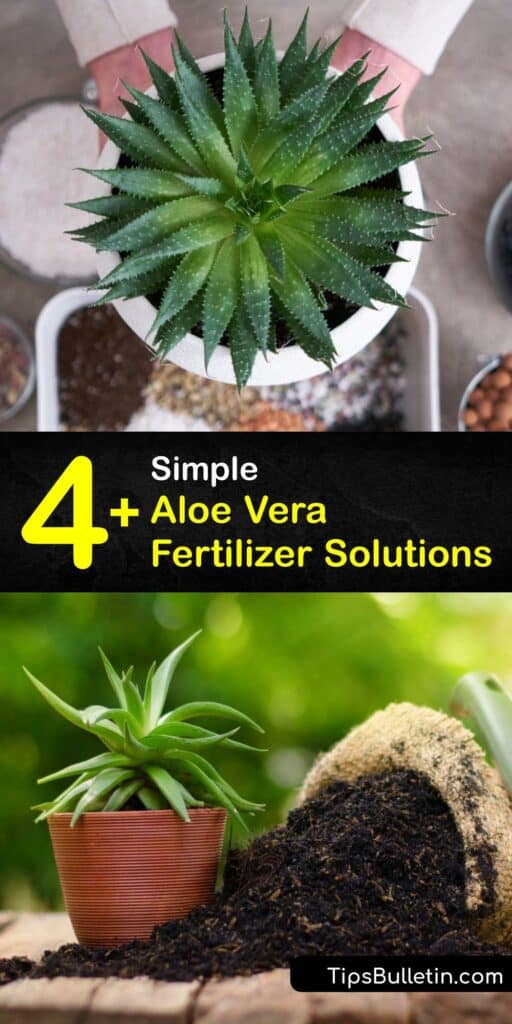There are 16 primary nutrients your aloe plants and beautiful succulents need for healthy plant growth. When plants lack these nutrients or proper growing conditions, root rot or discolored and dying leaves appear. Learn how to make homemade fertilizer for aloe vera plants to resolve these nutrient issues as soon as you spot any trouble.
Aloe vera plants are loved for their green leaves and sometimes colorful flowers, and the aloe gel inside these plants is often sought after. Aloe vera gel, harvested from the inside of mature leaves, is a popular ingredient for commercial cosmetic products and skincare.
Adding aloe vera plants to your garden adds color and variety. Some plants attract beneficial insects and natural predators to pests. Because of their varying sizes, succulents are popular as indoor plants. Discover several helpful options when looking for ways to use natural supplies to fertilize your aloe plants.

How to Fertilize Aloe Vera
Macronutrients for aloe plants include nitrogen, potassium, magnesium, phosphorus, and calcium. While micronutrients like iron are essential, aloe plants only need them in small amounts, whereas a lack of macronutrients directly affects the growth and health of your succulents.
Organic Aloe Vera Plant Fertilizer
Can you make a DIY fertilizer for aloe vera from egg shells? Although eggshells may seem like nothing more than waste after cracking the egg, the shells provide calcium when used in the garden. To use eggshells as fertilizer, rinse and dry at least ten eggshells to remove any lingering egg protein.
Bring water to a boil and add crushed eggshells. Boil the shells for five minutes before allowing the water to cool. Add apple cider vinegar to help draw calcium from the eggshells. Transfer the water to a container to steep for two days. Remove the crushed eggshells before using the tea to water your plants.

Use Banana Peels as Aloe Vera Plant Food
Typically, store-bought aloe vera soil comes packed with all the essential nutrients succulent plants need to thrive. If you create a potting soil mix for growing succulents, you may experience a lack of nutrients that affects the growth of your succulent and cactus plants.
If your succulents lack potassium, add banana peels to the soil instead of throwing them away to draw out the available potassium. To make the best fertilizer for aloe vera plants with banana peels, save empty peels in your freezer.
Once you have a collection of peels, cut them up and bury them in the soil around succulent plants. Fertilizing aloe vera plants effectively allows you to add a slow-release fertilizer for succulents.
How to Make Succulent Fertilizer With Manure
Manure, or the waste from animals that do not consume meat as part of their diet, is an excellent source of plant nutrients. The waste from chickens, horses, sheep, and rabbits contains essential nutrients to help aloe vera grow. Instead of amending your soil with manure at the start of the growing season, soak manure in water to create a liquid fertilizer.
Place an old pillowcase inside a bucket and secure it to the rim with string. Use a shovel to add manure to the bucket until it is two-thirds of the way full. Fill the bucket with water before closing it with a lid for at least two days, stirring occasionally.
Remove the pillow case and allow the liquid to drain before diluting the bucket with more water to make the manure tea light brown.
Note: If you do not have manure, finished compost is an excellent natural aloe vera fertilizer.
Homemade Fertilizer for Aloe Vera Plants
The most crucial of all nutrients for aloe plants is nitrogen. Aloe vera plants absorb nitrogen through the soil as nitrate or as ammonium to help with overall growth. For other plants, nitrogen is essential because it boosts seed development and fruit production.
Without sufficient nitrogen, plants may develop leaf chlorosis, when leaves turn light green before older leaves turn yellow. Developing succulents experience stunted growth without enough nitrogen, which may affect secondary shoots.
Seaweed and kelp fertilizers add nitrogen to the soil; however, an inexpensive way to accomplish this at home is by using grass clippings as natural fertilizer. Grass is full of nitrogen, and when left to break down on your lawn, those nutrients find their way back to the ground to help the grass roots grow again.
The next time you mow the grass, use a bag attachment to save the clippings before sprinkling them evenly around the base of your succulents as an organic aloe vera plant fertilizer.
Natural Fertilizer for Aloe Vera
Magnesium is a macronutrient for aloe plants affecting plant photosynthesis. Lack of magnesium is displayed in aloe plants by an older leaf turning yellow or bright green. Aloe leaves also curl upward before falling off if magnesium levels in the succulent soil remain low.
One solution for adjusting the magnesium available for your plant is to use Epsom salt dissolved in water as a foliar spray. Epsom salt is magnesium sulfate, and when applied to leaves, it allows the plant to absorb the nutrients directly.
Dissolve Epsom salt in the water before adding it to your spray bottle. Apply the spray to succulent leaves as long as signs of a magnesium deficiency last.
Note: Another option is to carefully dig into the soil and add a tablespoon of Epsom salt before watering your succulent to apply the salt as granular fertilizer.
The Risks of Using Homemade Aloe Vera Fertilizer
Creating an organic aloe vera plant fertilizer saves money and helps address specific issues in your garden; however, there are downsides to using a DIY organic fertilizer. It’s important not to overfeed your plants. Providing your plants with too much food negatively affects their health, just like overwatering does.
Supplying your plant with too much of a particular nutrient, like magnesium, harms the plant by hindering its ability to intake other vital nutrients like calcium. Succulents absorb phosphorus as phosphate, which benefits photosynthesis. In excess, phosphorus may cause plants to grow slowly, and too much phosphorus may even be lethal to plants.
Soil tests are excellent for determining if your garden lacks a specific nutrient, but this method is less effective when growing succulents in containers. Monitoring your plant for signs of a deficiency is the best way to tell when to take action.
While most succulents don’t have long lives, if they are cared for properly, they create offsets that continue to grow in place of the original plant. We hope by learning how to fertilize aloe vera using natural ingredients, you find it easy to care for succulents in your garden.

If you discovered new ways of making homemade fertilizer for aloe vera plants, please share our guide on how to fertilize aloe vera plants with your friends and family on Facebook and Pinterest.